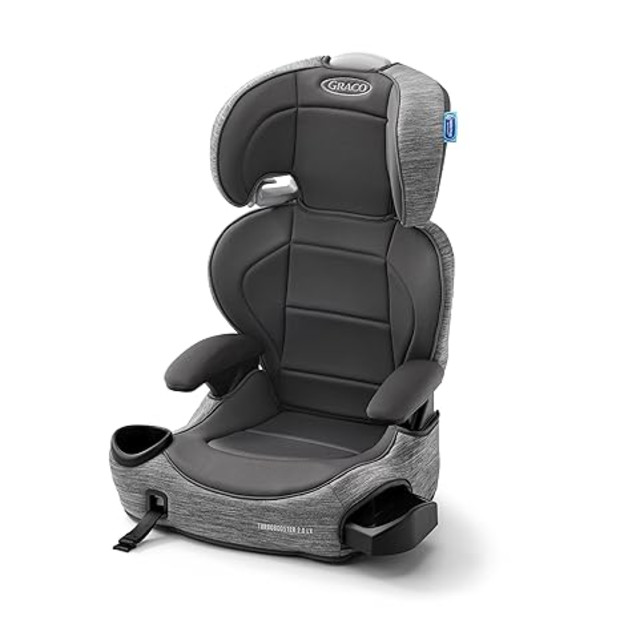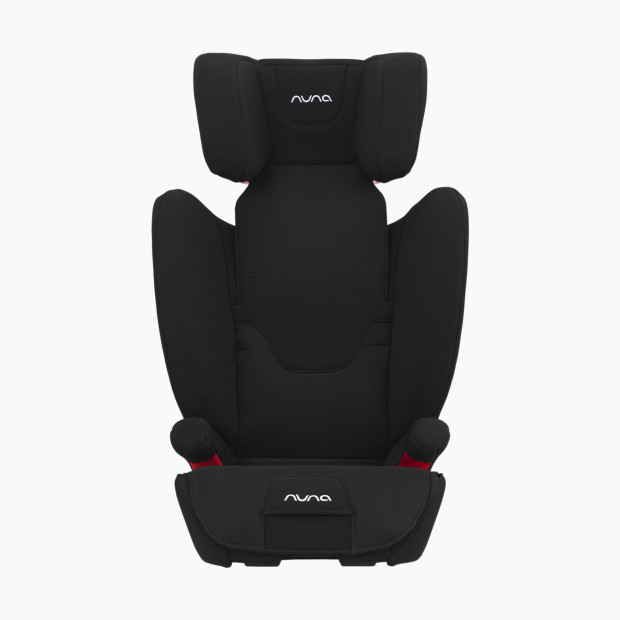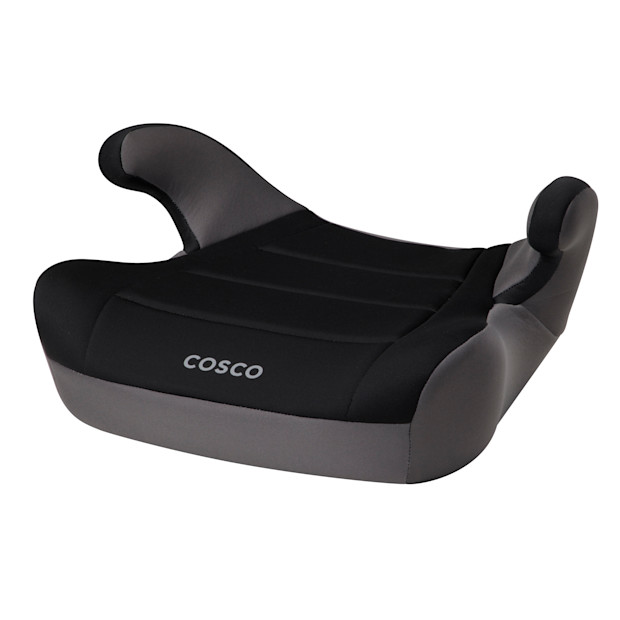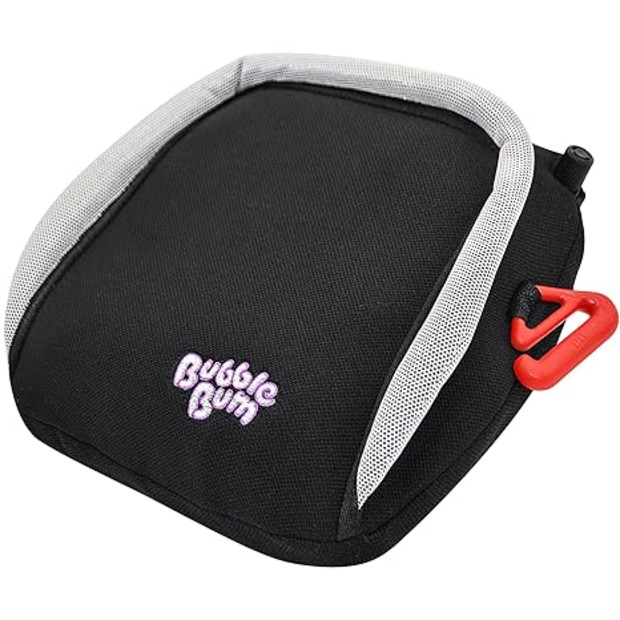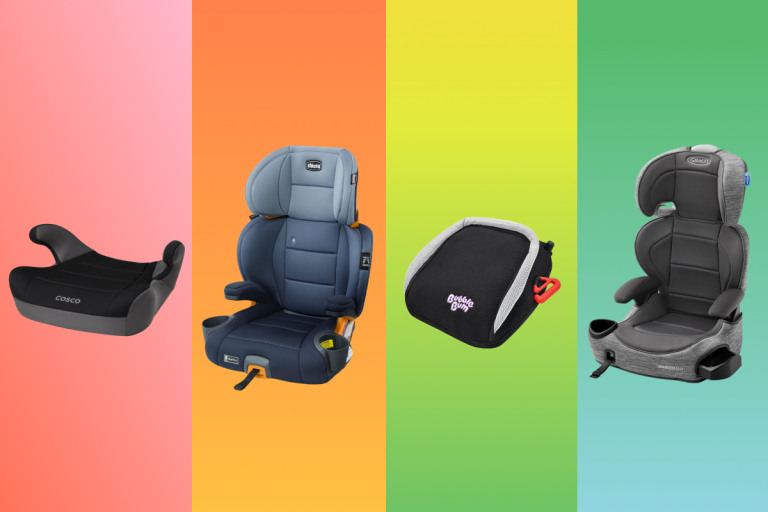
You Need a Booster for Years—These Are the Best That Grow with Your Child
Your child should use a booster seat well into elementary school. Here’s your guide to buying the right one.

By Jen LaBracio, CPST
Fact Checked by Shannon Vestal Robson
In This Article
From infant car seats and convertibles to boosters, when it comes to car seats, you’re in it for the long haul. This is especially true for booster seats, which often have the longest lifespan of any car seat you’ll own—your little one will be riding in one for years.
A booster seat is designed to help an adult seat belt fit on a child’s body. As a Child Passenger Safety Technician (a CPST, a specially trained car seat educator) and Babylist’s senior gear editor, I field a lot of questions from parents around boosters: when to transition to one, the different types of booster seats, which ones work in which vehicles and more. We’re covering all of those topics in this comprehensive guide, as well as offering product recommendations, including the Graco TurboBooster 2.0 LX as the best booster seat for most families and several other all-in-ones to fit every family’s needs.
- Best Mid-Range
 Chicco KidFit ClearTex Plus 2-in-1 Belt-Positioning Booster Car SeatFrom $99.99
Chicco KidFit ClearTex Plus 2-in-1 Belt-Positioning Booster Car SeatFrom $99.99
Why Trust Babylist?
Babylist is the expert in baby; we know baby gear inside and out. We talk with parents face-to-face in our showroom and on our user panels and hear from thousands annually via our Best Baby Products online survey. We know what items millions of expecting parents are adding to their baby registries.
Firsthand professional and personal experience. As a CPST, I’m specially trained in car seat installation, usage, safety and education, including for booster seats. I stay up-to-date on car seats through continuing education classes, seminars and CPST education groups. I'm also Babylist's gear editor; I've been writing about baby gear at Babylist since 2019 and have been the gear editor since 2021. I’ve personally tested and reviewed dozens of booster seats in this role. I’m also a mom of two boys, ages three and ten—so I have over a decade of booster seat experience in my personal life.
Expert POV. In addition to my own car seat knowledge, I consulted Lani Harrison, a CPST with over a decade of experience in the world of car seat safety. She weighed in on why and when to use a booster seat and shared some of her favorite booster options across all different price points.
Booster seat data. I regularly analyze which baby products our users are adding to their baby registries the most (and which ones they aren’t) and what our team of Merchandising experts—our buyers who are responsible for ensuring the Babylist Shop is stocked with the best and newest gear—is excited about. Studying this kind of data helped us choose which booster seats to narrow in on and which ones to recommend to new and expecting parents.
Feedback and reviews. I reviewed comments and feedback from Babylist’s annual product survey of thousands of parents, read customer reviews from hundreds of Babylist users and spoke to parents on our staff about their real-life diaper experiences.
How We Judged
Best Booster Seat Overall
Pros
- Fits most vehicles and most kids well
- Converts from high-back to backless booster for extended use
- Easy install with LATCH
Cons
- No overhang allowed (booster can’t extend beyond vehicle seat), so may not work in shallow seat positions
- Cannot use in high-back mode in vehicles with nonremovable headrests
- Not as padded or plush as some higher-priced options
- Slightly narrow seat
As a CPST, one of the most important things I look for in any car seat is fit—both how the seat fits a child and how it fits in a vehicle. The Graco TurboBooster is my favorite type of seat: a unicorn that fits most vehicles and most children well. Combined with the seat’s budget-friendly price point, easy install and long lifespan, it’s the best booster seat option for most families.
“The Graco TurboBooster generally gives good positioning in a variety of vehicles,” explains Harrison. This means you’re likely to get the proper (and safest) fit no matter what kind of car you drive. This booster seat also doesn’t require a vehicle headrest behind it when you’re using it in high-back mode, so if you’re having any issues installing the seat—and if your vehicle allows for it (always check your manual!)—you can remove them for a correct fit.
The TurboBooster features an adjustable headrest, padded armrests and energy-absorbing foam. It’s fairly light at about 10 pounds, so it works well for carpooling. And it transitions from a high-back booster to a backless one when your child is ready, so you’ll get many years of use out of it.
There is a cheaper version of this booster seat available, the TurboBooster 2.0. It’s comparable to the LX version in many ways except for one: there are no LATCH connectors. LATCH connectors don’t affect a booster seat’s performance and you can use most seats without them; however, they do keep the seats stable as kids climb in and out and keep them secure when not in use. (An unsecured booster seat acts as a projectile in a crash.)
Keep in mind that the TurboBooster LX's seat pan is slightly narrow, so it won’t work for some larger children, and it won’t work in shallow seats as it can’t overhang the vehicle seat—but that’s not an issue in most vehicles. Another nuance to be aware of is that you can’t use this booster in vehicles with nonremovable headrests. (Many Tesla models have nonremovable headrests, as do some other vehicle makes and models.) Again, this isn’t an issue in most vehicles, but it is in some, so be sure to check both your headrests and your vehicle manual before purchasing any booster seat.
Additional Specs
Child Guidelines: high-back booster: 40-100 lbs, 43-57”, at least 4 yrs old; Backless Booster: 40-100 lbs, 43-57”, at least 4 yrs old
Seat Weight: 10.7 lbs
Level Up Pick
Nuna AACE Booster Car Seat - Caviar
From $280.00Pros
- Rigid LATCH = super secure install
- Fits most vehicles and most kids well
- Converts from high-back to backless booster for extended use
- Works in vehicles with nonremovable headrests
Cons
- Expensive
- Heavy
“This is one of my favorite boosters,” says Harrison, and I couldn’t agree more. If the Aace fits your budget, it’s well worth the upgrade and is an excellent option for keeping your older child safe for many years.
Much like the TurboBooster, the Aace excels in fit, both for the rider and the vehicle. “It gives excellent seat belt fit and seems comfortable for [most] kids,” explains Harrison. “It also works well in vehicles with protruding headrests.” Then there’s the rigid LATCH, the way the seat attaches to your vehicle. “Rigid” means that the metal connectors that protrude from this booster’s base attach directly to the metal lower anchors of your vehicle—no straps or hooks involved. This is not only foolproof, but extremely secure, meaning your car seat will move as little as possible in the event of a crash.
Other thoughtful features include nine adjustable headrest positions, three seat depths and a belt-positioning system that works simultaneously with the booster’s headrest. (The shoulder area expands as the headrest goes up, providing kids with more room and a better fit as they grow.) The Aace is also compatible in vehicles with nonremovable headrests.
The downside to this booster is price: it’s expensive. But as it also converts to a backless booster and has an extremely high height and weight maximum (20 pounds and three inches higher than the max limits of the Graco TurboBooster), you’ll be able to use it for a long time. It’s also on the heavier side at about 15 pounds.
Additional Specs
Child Guidelines: high-back booster: 40-110 lbs, 38-60”, at least 4 yrs old; Backless Booster: 500-120 lbs, 38-60”, at least 5 yrs old
Seat Weight: 10.7 lbs
Best Mid-Range
Chicco KidFit ClearTex Plus 2-in-1 Belt-Positioning Booster Car Seat
From $99.99Pros
- Comfortable fit for most kids, especially younger booster riders
- Converts from high-back to backless booster for extended use
- GREENGUARD Gold Certified
Cons
- Wide
- Cannot use in high-back mode in vehicles with nonremovable headrests
The KidFit from Chicco falls in the middle of the pack on price and offers an impressive selection of features for such an accessible seat. Like many of the seats on our list, this lightweight seat converts from a high-back booster to a backless option for years of use. It boasts LATCH connectors, side-impact protection, 10 height positions, a two-position backrest and double-foam padding for added comfort. There are also retractable cup holders, a great add if you need to save space in your back seat.
If you’re chemical-conscious, know that the KidFit Plus is made from ClearTex fabric that’s both GREENGUARD Gold Certified and meets federal car seat flammability standards without the addition of flame retardants. I also appreciate that all of the fabrics are removable and machine washable. (The cup holders are dishwasher-safe, too.)
This booster does have some quirks, according to Harrison. “Chicco recommends you buckle the booster when it’s not in use, even though it has LATCH, which isn’t really the industry standard,” she explains. (It’s usually one or the other.) It’s also on the wider side. But it “gives an especially good fit on younger booster riders,” she says. And you won’t be able to use the seat in high-back mode if your vehicle has nonremovable headrests.
Additional Specs
Child Guidelines: high-back booster: 40-100 lbs, 38-57”, at least 4 yrs old; Backless Booster: 40-110 lbs, 38-57”, at least 4 yrs old
Seat Weight: 10 lbs
Best Affordable
Pros
- Under $20!
- Weighs under 3 pounds
- Fits most vehicles and most kids well
- Works well 3-across
Cons
- No LATCH connectors
- Shallow seat
As kids grow, so do carpools; most parents will need at least a few boosters on hand when they start carting kids around to activities, playdates and birthday parties. Whether that sounds like you—or if you’re simply in the market for an affordable booster seat—the Rise LX from Cosco is a fantastic option.
“The Cosco Rise is one of the best values out there,” says Harrison. This backless booster fits a wide variety of cars well and has a wide base to accommodate kids of all different sizes. (The wide base also prevents the booster seat from tipping over when kids climb in and out, an added perk.) The Rise is extremely light, weighing under three pounds, and the narrow width means you can go 3-across in most vehicles. And there’s zero assembly involved; just take it out of the box and you’re ready to ride.
Since this is a backless booster, keep in mind that it’s better suited for more experienced or older booster riders who know how to sit properly. And note that the seat itself is on the shorter side, so some older or bigger riders may not be as comfortable in it as they would be in a seat with a longer depth. If you need a backless booster seat for a larger child, check out the similarly affordable Diono Solano. This wider booster “gives an excellent fit on larger kids,” according to Harrison.
Additional Specs
Child Guidelines: 40-100 lbs, 43.4-57”
Seat Weight: 2.65 lbs
Best for Travel
Pros
- Inflatable; fits in small bag when deflated
- Weighs <1 pound
- Includes seat belt positioning clip
Cons
- Best for older or more experienced booster riders
- Some kids find it uncomfortable for longer rides
The BubbleBum is more than just a fun name—it’s an innovative product that solves the huge problem (and inconvenience) of traveling with big, bulky booster seats. This booster seat is inflatable, so when it’s not in use, it’s compact and easy to toss into a backpack or even a small bag. It’s also great for three-across since it’s a narrow, compact seat that fits between two full-size car seats and it works for carpools, too.
Since there’s no back to this booster, it’s better suited for older children or kids who know how to sit properly in a booster seat. Some children also find it uncomfortable after longer periods of time.
Additional Specs
Child Guidelines: 40-100 lbs, 40-57”, at least 4 yrs old
Seat Weight: 1 lbs
Best for Larger Kids
Pros
- Good fit for larger/heavier kids
- Converts from high-back to backless booster for extended use
- Works in vehicles with nonremovable headrests
Cons
- Seat and back portion don’t stay connected when moving seat
- Wide
Kids come in all different shapes and sizes, and so do booster seats; a seat that fits one six-year-old well might offer a terrible fit for another. The Cambria 2 from Diono really shines for larger and heavier kids thanks to the ergonomic design of the wide, contoured base and the deep padding throughout.
While there are other Diono booster seats that work well for larger kiddos, Harrison calls out the Cambria as a particular favorite due to fit and ease of use. “The headrest is taller top to bottom,” she explains, “And the longer armrests seem to keep the [seat] belt in place much better.” You’ll also be able to use the Cambria in high-back mode even if your vehicle has nonremovable headrests.
If you’ll need to take this booster seat in and out of your vehicle often or frequently switch it between cars, know that while it’s lightweight and easy to move, the seat portion and high-back portion come disconnected fairly easily. It’s not a huge deal, but it is something to note. And while the wider design is great for bigger kids, it will take up a bit more room in your car.
Additional Specs
Child Guidelines: high-back booster: 40-120 lbs, 38-63”, at least 4 yrs old; Backless Booster: 40-120 lbs, 38-63”, at least 4 yrs old
Seat Weight: 12.8 lbs
What Is a Booster Seat?
A booster seat raises and positions a child so the vehicle’s seat belt fits properly. “The point of a booster seat is to serve as an adapter to help the seatbelt fit a child,” explains Harrison. “It brings the seat belt down to the size of the child so that it can correctly protect a person of that size.”
After a child outgrows a forward-facing car seat, they’re still not big enough to be in the correct position for your vehicle’s seat belt to do its job: saving your child from injury should you get into an accident. Straps that lay against the neck or across the belly can actually do harm instead of good in the event of a crash. Booster seats ensure your vehicle’s seat belt is in the proper position on your little one’s body.
Types of Booster Seats
There are two types of booster seats: high-back boosters and backless boosters.
A high-back booster has a back and a bottom. High-back boosters provide head, neck and back support. They also offer a seat belt guide through which you can thread a vehicle’s shoulder belt to make sure the fit is exactly where it needs to be. On some, the backrest can be adjusted for height, and most high-backs have padded headrests.
Backless boosters have only the seat component to provide the extra height needed to properly position your child in your vehicle. Backless boosters have seat belt guides that position the belt over the correct place on the child’s body. These types of boosters are generally less expensive than high-backs.
There’s one more category of booster seats that is a bit of a hybrid: combination seats. Sometimes also called harnessed boosters or harnessed car seats, these hybrid seats can function either as a forward-facing car seat with a five-point harness (for children up to at least 40 pounds) or a belt-positioning booster for kids over 40 pounds. In these types of seats, the back portion of the seat is not usually removable.
Is a high-back booster better than a backless booster?
High-back boosters generally do a better job of correctly positioning both your child’s body and your vehicle’s seat belt. “A high-back booster gives support behind the child’s back and provides side impact protection,” explains Harrison. “Without the back of the booster, the child has the freedom to lean back and sink into the vehicle seat. Many vehicle seats have a concave shape in the middle, which makes kids sink back even further.” While this is a comfort feature for adults, says Harrison, it can be unsafe for smaller riders.
A high-back booster also helps correctly position a vehicle’s lap and shoulder belt. “Shoulder belts can come from many different locations in the car (ceiling, wall, the seat itself); the shoulder belt guide on a high-back booster automatically places the shoulder belt in the correct position,” she says. A high-back booster will also keep a child’s pelvis lined up in the correct position so that the lap belt will be placed appropriately, according to Harrison.
Once your child has outgrown their high-back booster, a backless booster gives most children appropriate positioning. Just be sure that the vehicle seat comes up to your child’s ears. If their ears come up past the vehicle seat, they should use a high-back booster to prevent head and neck injuries.
When to Transition to a Booster Seat
There’s no rush to move your child from a harnessed car seat into a booster. In fact, moving them too early—a common mistake—can actually be dangerous.
“The very minimum for transitioning into a booster seat is when the child is at least five years old and at least 40 pounds and can sit up and sit still for the entire car ride,” says Harrison. (Prior to that age and weight, children need to ride in a harnessed car seat.) But the five-year-old age recommendation is just that—a recommendation. Many children aren’t booster-ready until six or even seven years old. “In my experience, there are very few five-year-olds who have the maturity to sit up and sit still for the whole car ride,” Harrison says.
It’s safe to move your child from a harnessed car seat to a booster when all of these parameters are met:
Max out your forward-facing car seat. Don’t consider transitioning your child to a booster seat until they have reached the maximum weight and/or height limit of your forward-facing car seat. For some seats, that’s around 40 pounds or five years old, while others have much higher limits.
Meet the height and weight requirements of a booster seat. All car seats, including boosters, have a minimum height and weight requirement for use. Before transitioning to a booster, be sure your child meets your particular seat’s requirements—but don’t rush the switch and don’t focus on the minimums alone, especially weight. While many booster seats have a 40-pound minimum weight, you can’t determine if a child is ready for a booster on weight alone. (More on that below.)
Are mature enough to sit properly 100% of the time. This is a big one. You need to consider the freedom of movement that a booster allows before making the switch. A car seat has a five-point harness, so when it’s properly tightened, it doesn’t allow your child the freedom to move around all that much. A booster, however, does not. And leaning over, twisting, reaching over to poke a sibling…none of these are safe positions for your child to be in while you’re driving. In order to be booster-ready, your child must be able to sit properly 100% of the time, even when asleep.
Have a safe seatbelt fit. You need to be sure the booster you choose fits your child properly. The lap belt should be low and across your child’s hips, touching the upper thighs—never across their abdomen. The shoulder belt guide should be positioned above the shoulder and the shoulder belt should be across your child’s chest, making contact with the shoulder. The top of the child’s ears should not be above the top of the vehicle seat.
Frequently Asked Questions
How does a booster seat attach to a car?
Booster seats sit in the back passenger seat of a vehicle. Some boosters rest directly on a vehicle’s seat without being tethered down. Others use LATCH connectors that attach to your car’s lower anchors to keep the booster secured to the vehicle seat. This doesn’t affect your child’s safety while riding in it, but eliminates the booster sliding around when your little one is getting in and out. It can also prevent a booster seat that’s not being used from becoming a projectile in the event of a crash. If the booster you choose doesn’t have connectors, be sure to stow it in your trunk or secure it down with a seatbelt when your child isn’t in it.
Is a harnessed car seat safer than a booster seat?
Assuming your child meets the height and weight requirements of their booster seat, can achieve a proper booster seat fit and can sit properly for the entire length of a car ride, a harnessed car seat does not provide any more protection than a booster seat.
When can my child stop using a booster seat?
Children should stay in a booster seat until the adult seat belt fits correctly—usually when a child reaches about four feet nine inches and is between eight to 12 years old. Here’s how you know it’s time to ditch the booster:
Your child can sit in your vehicle with their back against the seat and their knees bent over the edge of the seat with their feet on the floor, and can remain safely in this position throughout the car ride.
Your vehicle’s shoulder belt lies across the middle of your child’s chest and shoulder, not their neck or throat.
The lap belt is low and snug across their hips, touching the tops of their thighs.
